Tom's Hardware Verdict
SteelSeries brings forward the same award-winning design of previous Arctis headsets with the Arctis 9 Wireless. The sound is still mostly great, even if the competition has caught up or surpassed the line, but if you don't need Bluetooth, the $50 premium over the Arctis 7 might be hard to swallow.
Pros
- +
Impressive wireless connectivity
- +
Can connect to 2.4 GHz and Bluetooth simultaneously
- +
Great battery life
Cons
- -
Expensive
- -
Flat audio profile with muted bass
- -
Questionable durability
Why you can trust Tom's Hardware
SteelSeries has been on a run with its Arctis series of gaming headsets, first introduced in 2016 and bringing high-end audio and a great microphone in three price points. Combined with the unique ‘ski goggle suspension’ design, the Arctis headsets made players stand up and take notice of SteelSeries in another hardware category. While the line started with the SteelSeries Arctis 3, SteelSeries Arctis 5 and SteelSeries Arctis 7, it has since expanded with the low-end Arctis 1 and the upper-end Arctis 9X and Arctis Pro cans.
Our review focus, the SteelSeries Arctis 9 Wireless ($200 as of writing) builds on the same design of SteelSeries’ Arctis Pro Wireless and Arctis 9X Wireless. The latter is designed for Xbox One consoles, connecting to the system without the need for cables or a dongle. It also offers SteelSeries' ClearCast microphone, a Discord-certified mic with great clarity and a simultaneous Bluetooth connection. If you're an Xbox gamer, the Arctis 9X Wireless is a great choice. For everyone else though, SteelSeries needed to offer up another candidate for best gaming headset.
Enter the Arctis 9 Wireless, which trades in an Xbox wireless connection for a wireless dongle with support for PC, PlayStation 4, the upcoming PlayStation 5 and the Nintendo Switch in docked mode. Otherwise, it carries the same audio drivers, design, simultaneous Bluetooth connection and price point as the Arctis 9X Wireless.
SteelSeries Arctis 9 Wireless Specs
| Driver Type | 40mm neodymium |
| Impedance | 32 Ohms |
| Frequency Response | 20 Hz-20 KHz |
| Microphone Type | Arctis ClearCast bidirectional mic |
| Connectivity | 2.4 GHz USB Type-A wireless dongle cable, Bluetooth 4.1 |
| Weight | 0.8 pounds (376g) |
| Cords | 5.1-foot (1.6m) charging cable, 3.4-foot (1m) USB dongle cable |
| Lighting | None |
| Software | SteelSeries Engine 3 |
Design and Comfort of SteelSeries Arctis 9 Wireless

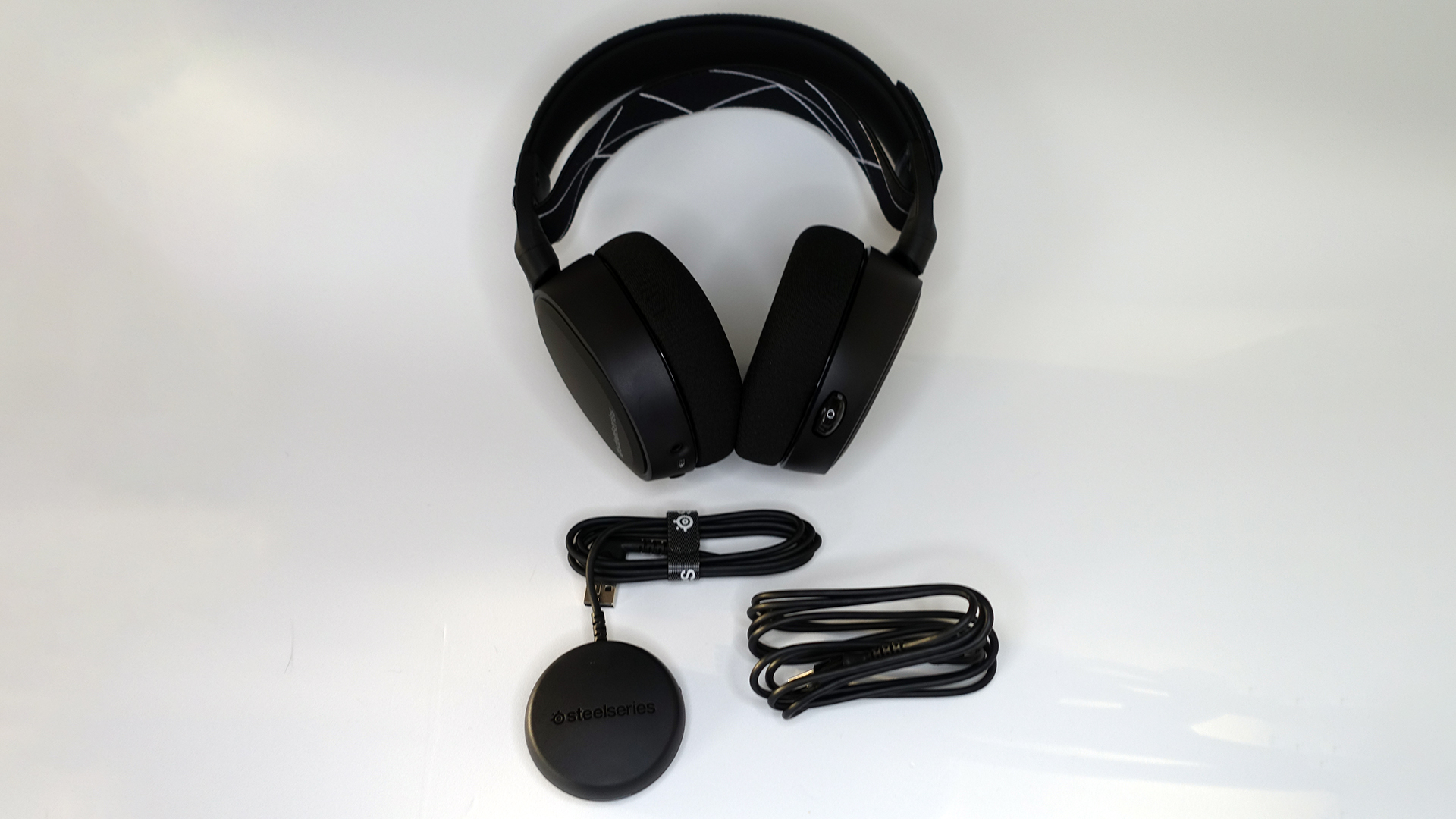
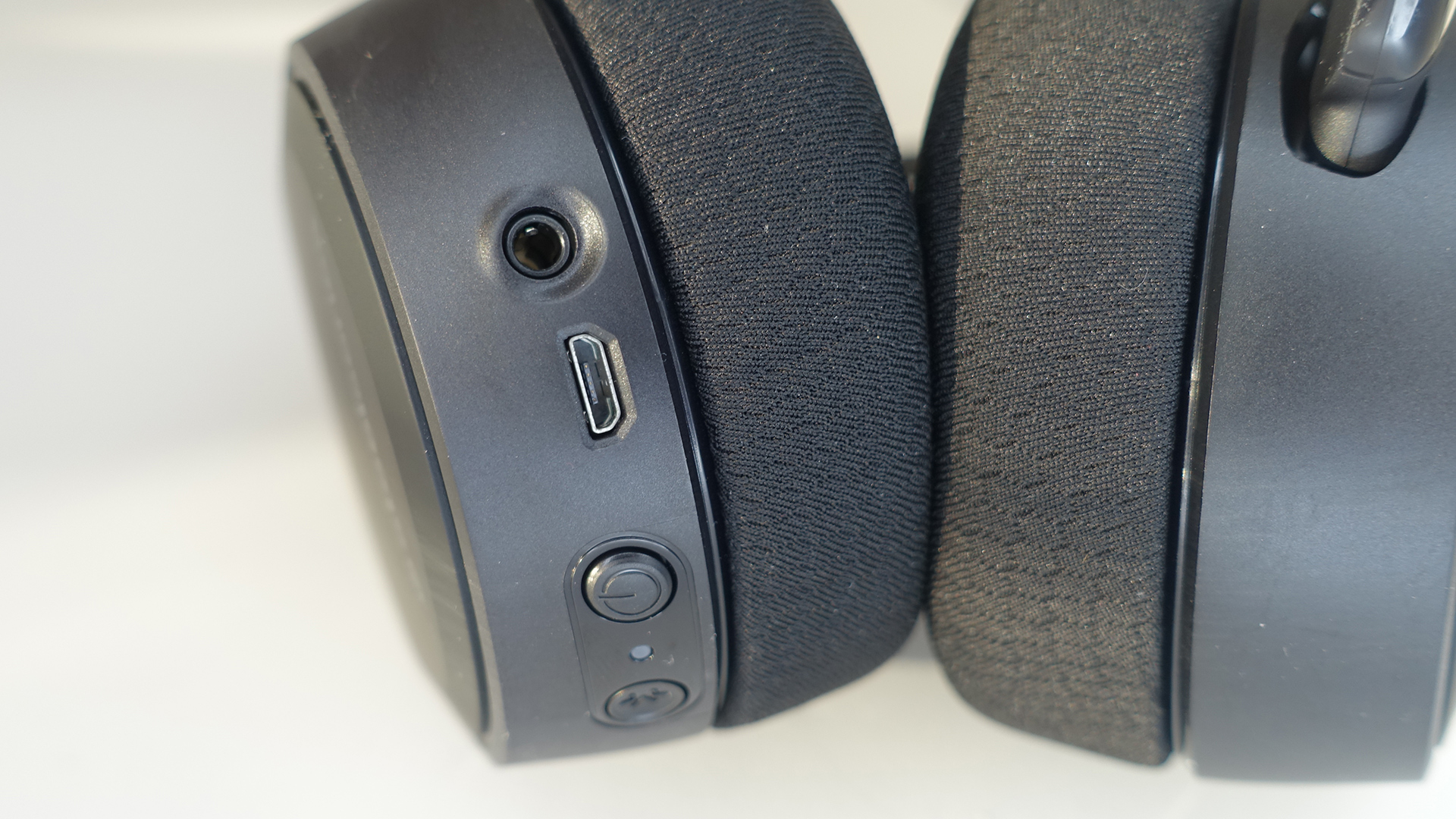
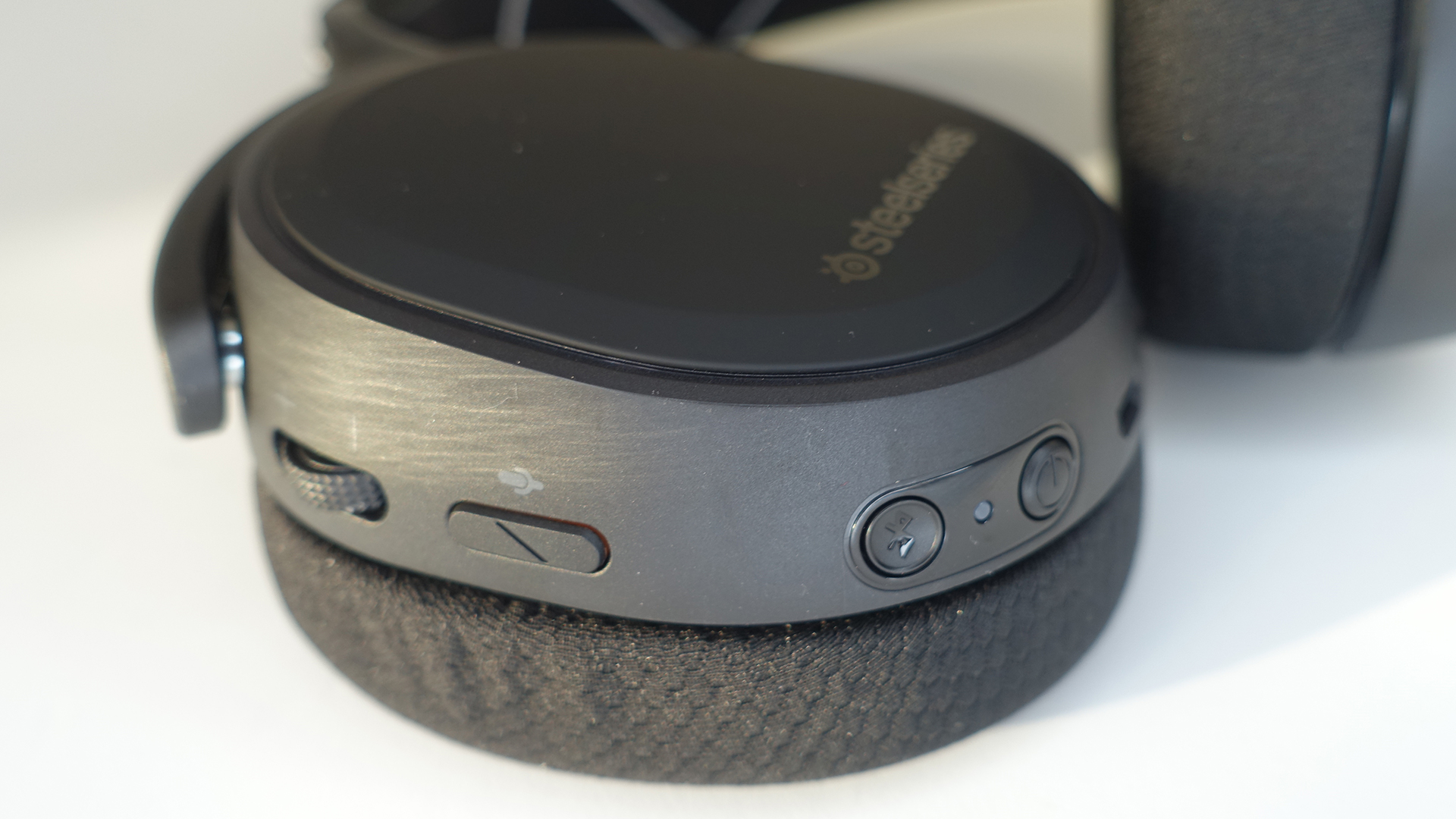
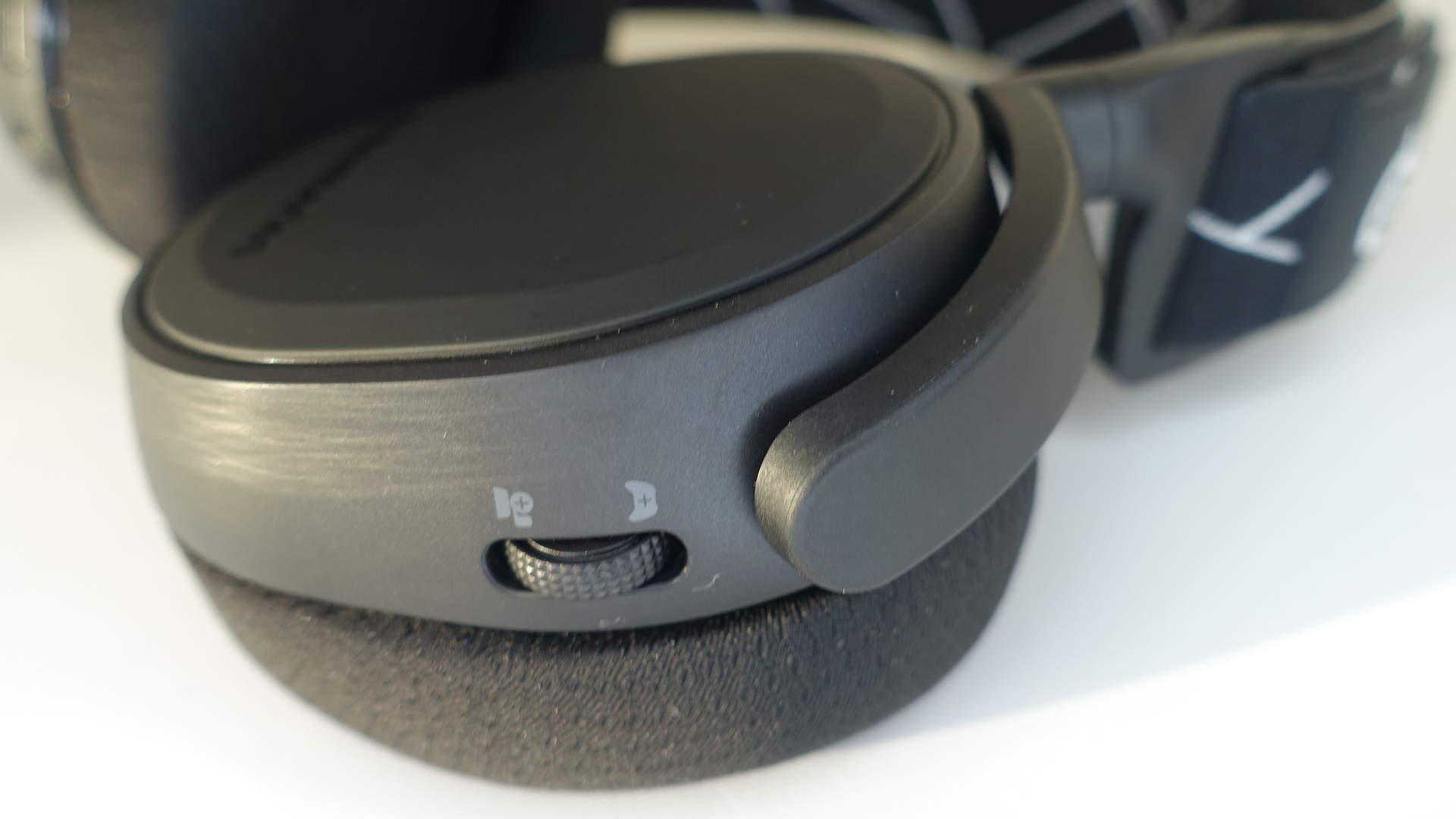


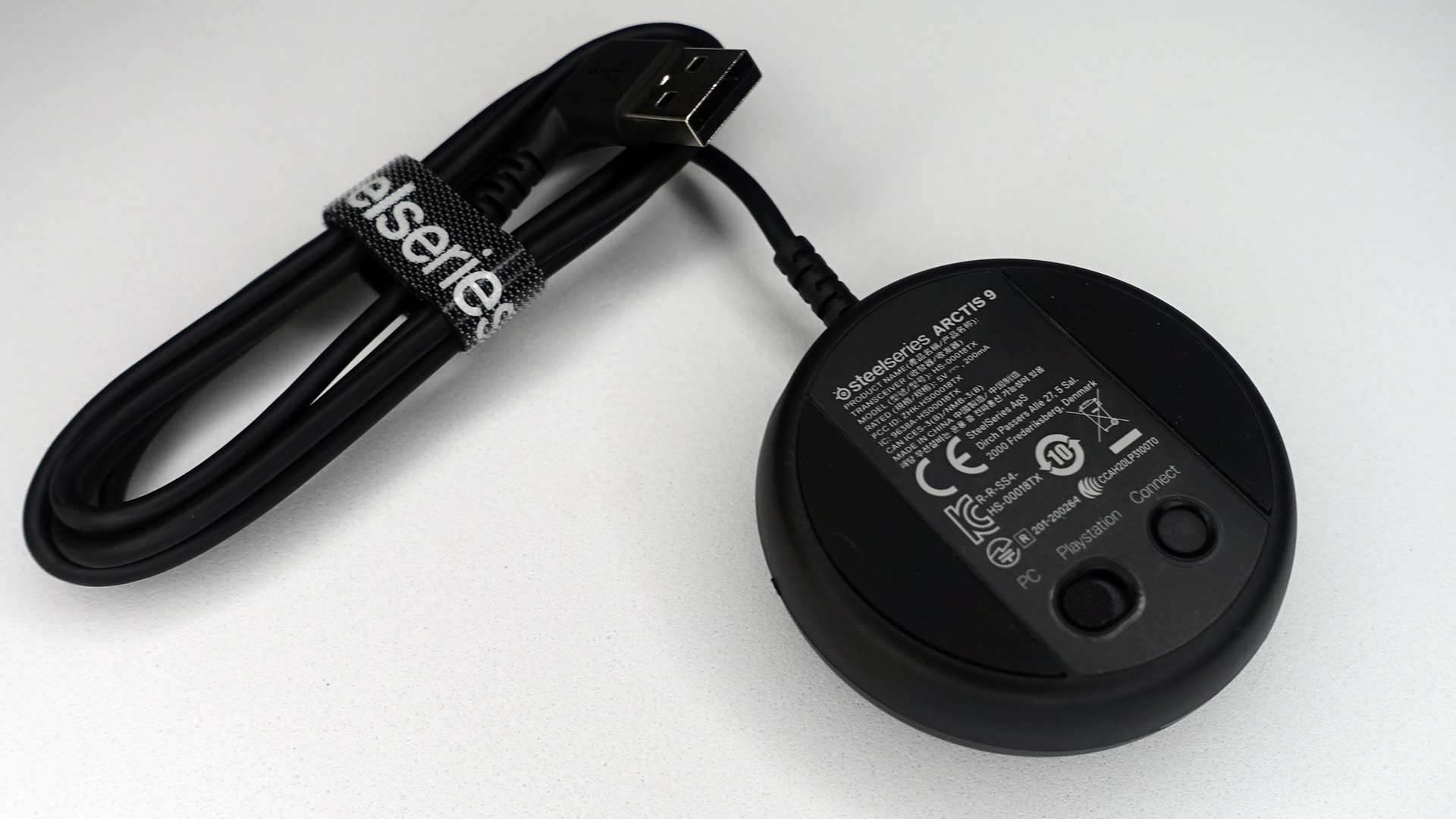

SteelSeries has settled on a strong design with its high-end Arctis headsets. There's no RGB lighting here, casting the entire unit in a clean look; only the white lines of the adjusting strap and SteelSeries logo break up the pure matte black. There are no exposed wires either, something that's a personal bugbear of mine in other cans, like the similarly priced Razer Blackshark V2 Pro and Logitech G Pro X Lightspeed. The Arctis 9 just looks so dang professional when you pull it out of the box the first time.
The ski goggle design also means this is an easy headset to fit on your noggin. A Velcro strap surrounds a steel headband and is adjustable for a tighter fit for smaller heads. The design makes it easy to pass the Arctis 9 Wireless to another person without too much tweaking. Many headsets push in on your head from the sides, but the Arctis 9 Wireless’ weight is actually held here by the strap around the headband. With the Velcro strap at the widest setting, I was able to fit it on my massive head, but the strap elasticity meant the ear cups were pushing up on the bottom of my ears. I got used to it, but those with big heads should keep this in mind.
Once it's on your head though, you'll barely feel the weight of it. The Arctis 9 Wireless, as well as the wireless SteelSeries Arctis 7, is 0.8 pounds. That’s a little heavier than some headsets I've recently reviewed, like the 0.7-pound wireless BlackShark V2 Pro. Logitech’s G Pro X Lightspeed, meanwhile, is also 0.7 pounds, and the Asus ROG Strix Go 2.4 is even lighter at 0.6 pounds. Despite some headsets being trimmer, the Arctis 9 Wireless felt weightless on my head.
SteelSeries’ Airweave cloth, which is supposed to take sweat into account, covers the ear cups’ light foam. Alternatively, leatherette here can often help block outside noise, and our review focus’ passive noise cancellation is weak. I was able to hear outside noise while wearing the headset. I could hear the typing on my clicky mechanical keyboard during slight lulls in my music, for example.
Get Tom's Hardware's best news and in-depth reviews, straight to your inbox.
The left ear cup contains the retractable microphone. This has always been one of the better choices from the Arctis line, as you can safely stow the mic inside the ear cup when you don't need it. That's much better than a hard microphone arm or a detachable option that you can lose. The microphone also has a red LED to let you know when it's muted. Finally, the ear cup also includes a ChatMix roller to change the mix between chat audio and game audio.
On the right ear cup, you'll find most of the controls: a volume roller, microphone mute switch, power button, Bluetooth button, Micro USB slot for charging and 3.5mm jack. Many manufacturers put the mic mute button on the same ear cup as the microphone, but I find that means that hitting the button puts an audible pop or click in your recording; putting it on the other ear cup minimizes that. Another good choice for SteelSeries here. There's an LED indicator in-between the power and Bluetooth buttons. When connected to the wireless dongle in PC mode, it blinks white. It blinks blue when connected to Bluetooth, and alternates when both connections are active.
The wireless dongle is actually a wired one instead of the USB drive-style dongle in most other wireless headsets. The dongle has a 3.4-foot USB Type-A cable, and the bottom of the unit has a PC/PlayStation switch and a pairing button. The Arctis 9 comes paired with the wireless dongle out of the box, making the unit mostly plug-and-play. I plugged it into my PC and was off to the races, no software installation required.
Moving the dongle over to my PlayStation 4 and changing the switch was equally easy, and the PS4 saw the headset immediately. I also used the wireless cans with a PlayStation 5, and true to SteelSeries' claims, the Arctis 9 works with the console. No muss, no fuss.
The USB cable included in the box is purely for charging purposes. Hooking the cable to a PC without the dongle does see the headset come up in Device Manager, but not for audio purposes. This is a wireless-only headset, pure and simple.
Arctis 9 Wireless Performance
SteelSeries rates the Arctis 9 Wireless to maintain its cable-free connection from up to 40 feet (12.2m), and I didn't have any problems with the connection, being able to walk around my entire apartment with nary a crackle or connection drop.
The Arctis 9 Wireless carries the same 40mm neodymium drivers you'll find in the Arctis 9X, Arctis Pro and Arctis Pro Wireless. When it first launched, the Arctis line boasted strong audio compared to other gaming headsets. But competitors have moved to newer drivers this year: Razer put its 50mm Triforce Titanium drivers in the new BlackShark line. Similarly, Logitech has its 50mm Pro-G drivers, and HyperX offers 50mm drivers on its mid-range headsets. The larger drivers can allow for stronger sound, especially in terms of bass. And the frequency response on the Razer BlackShark V2 Pro is simply higher, topping out at 28 KHz, as opposed to 20 KHz on the Arctis 9 Wireless.
Out of the box, sound on the Arctis 9 Wireless was good on the higher side of the profile but missing something. With no equalizer tweaking, the mids came across great, treble was decent, and bass was pretty disappointing. The bass here lacks punch in comparison to fellow competitors from 2020.
I loaded up the SteelSeries Engine 3 to tweak the sound settings in the equalizer, kicking up the bass in the equalizer and utilizing the Bass Boost preset. Even with those additions, that only brought the bass in the Arctis 9 up to 'good.'
Doom Eternal is one of my favorite PC games for testing bass, with the satisfying BOOM of the Super Shotgun always offering visceral excitement. But the shotgun's report wasn’t strong on the Arctis 9 Wireless.
The results in Death Stranding and Horizon Zero Dawn were a little better because both games have audio that leans slightly more on the mids and highs. The mechanical screams of the machines hunting Aloy and the soft patter of the Timefall weather come across with clarity on the Arctis 9 Wireless. This is largely a great headset in terms of audio, but in comparison to the BlackShark V2 Pro or the G Pro Wireless, it feels like the Arctis 9 can do better.
The Arctis 9 supports DTS Headphone:X v2.0 for its virtual surround sound. This is the standard for a number of different headsets, but the THX Spatial Audio on the Razer BlackShark V2 Pro, is more robust. That said, when I used the Arctis 9 Wireless with Borderlands 3, I could pick out the barks of enemies and the quips of my teammates from every direction. without suffering from sounds blending together too much. DTS Headphone:X v2.0 works well for surround sound gaming.
Over on the PS4, the sound profile in Ghost of Tsushima, which doesn't rely as heavily on bass, was also pretty darn good. Likewise, in Resident Evil 3, I could pick out every creak and groan on the mutated, undead hordes of Raccoon City. Note that you need to set the volume on the system and the headset. When I first hooked up the Arctis 9 Wireless, the audio was low, even with the volume all the way up on the PS4's headset volume slider. It took me a few minutes to realize I needed to turn up the headset volume roller as well.
On music playback, the story was much the same as it was on gaming. Listening to NCT's R&B heavy Resonance Pt. 1 album, I missed some of the deep thrumming that underpins the silky vocals of tracks like "From Home." The upbeat tones of BTS' "Dynamite" sounded excellent on the Arctis 9 Wireless, despite missing a tiny bit of the funk oomph; the distinctive pluck of the bass guitar was muted, robbing the track of some of its background color. The droning industrial of "On My Own" from Jaden Smith from the soundtrack for Marvel's Spider-Man: Miles Morales pushed forward on the Arctis 9 Wireless with solid percussion, as did Kid Cudi's background vocals. I'm not a hard audiophile in regard to music, but the Arctis 9 Wireless does what I need here.
For most of my testing, the Arctis 9 Wireless worked fine with no issues. In the last couple of days though, the left earcup occasionally wouldn’t put out any sound. This would happen sometimes when the headset was connected to my PC or PS4 via the wireless dongle. Resetting the headset and reinstalling the software did nothing. Sometimes it works for a while, only to drop out again eventually.
Looking online, we found numerous threads discussing similar issues. It's an intermittent problem, but when it happens, there's no way to reliably fix it. You just have to roll the dice and hope. We reached out to SteelSeries about this, and a spokesperson told us that it’s common for a small number of units to experience issues. If this happens, it’s recommended you contact the support team, “and if there is an issue with the headset, more often than not, we’ll just replace it.” The Arctis 9 WIreless has a 1-year warranty.
Microphone on Arctis 9 Wireless

SteelSeries opted for a retractable microphone with its ClearCast noise cancelling branding, a bidirectional design and Discord certification.
Microphone quality on these cans is great. Some recording I did sounded uniformly excellent and accurate for a headset mic. Noise cancellation was also solid. I had the news on in the background while recording one sound file, and that didn't come across in the recording.
The Arctis 9 Wireless will show up to every gaming session on Discord with no problem, capturing every errant scream you make in Phasmophobia.
Battery Life on Arctis 9 Wireless
SteelSeries has rated the Arctis 9 Wireless at 20 hours of battery life on a single charge. Testing across two days, I landed at just under that. This is pretty great for a wireless headset, especially since I’m you're more likely to charge it between uses than, say, the best wireless mouse or any of the best wireless keyboards. Since it charges over Micro USB rather than the faster USB-C, charge time felt long (around 4-plus hours), but you can still use the headset wirelessly while it’s charging.
The LED in between the power and Bluetooth buttons tells you the headset's charge status: Green for 100-50%, Yellow for 49-20%, Red for 19- 10% and then a blinking Red for 9-1%. You can also find a general battery level indicator in the SteelSeries Engine 3 software, but it lacks hard percentages for detailed monitoring.
Software on Arctis 9 Wireless
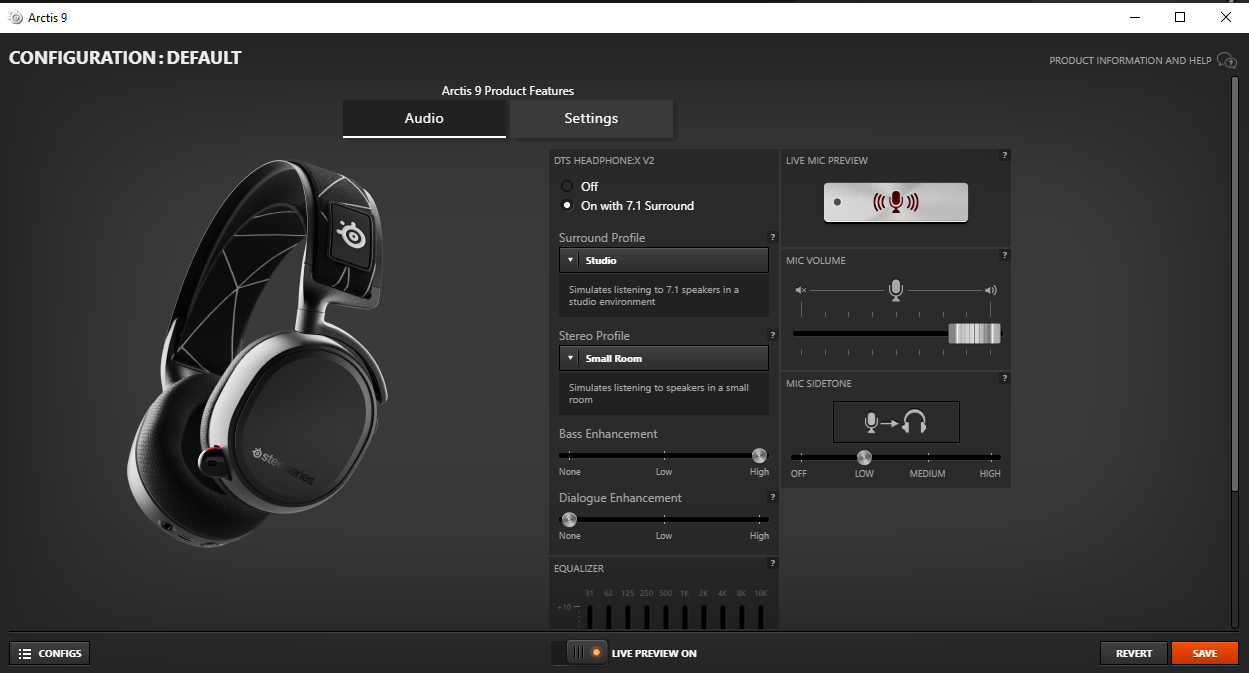
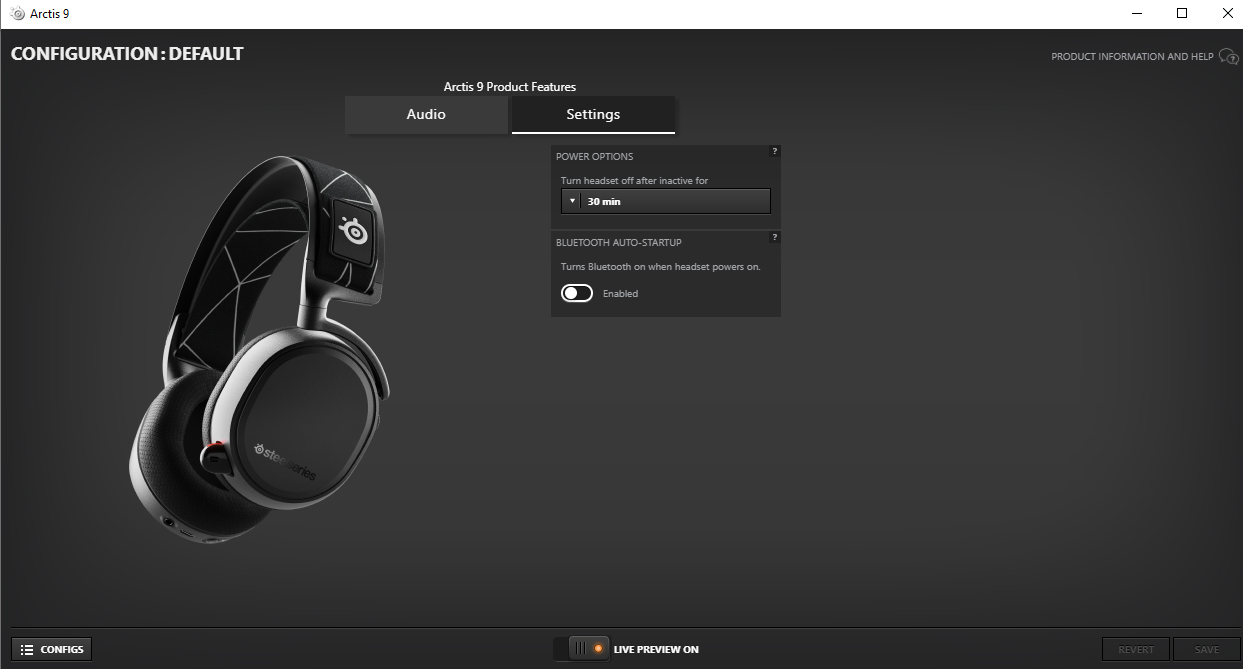
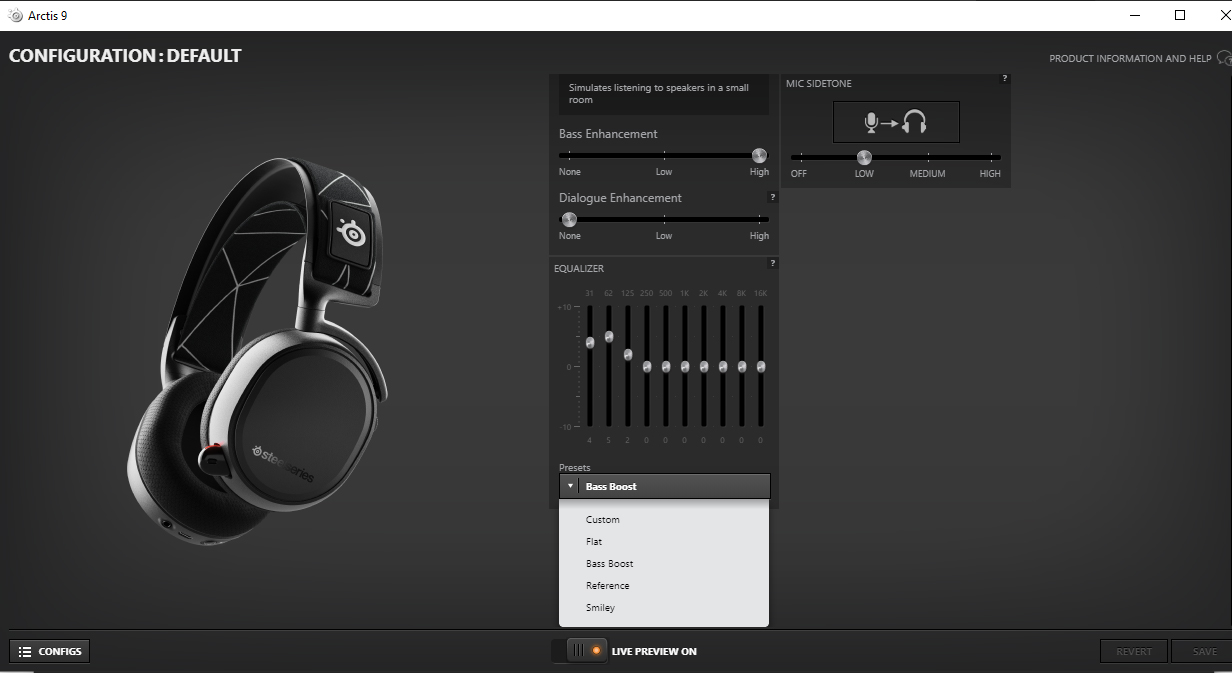

The SteelSeries Engine 3 is a little stripped down in comparison to software suites from other competitors. With DTS off, you get access to a 10-band digital equalizer and a few equalizer presents. With DTS on, you can change the Surround Profile (Studio, Game, Cinema), the Stereo Profile and enhance the bass or dialogue. The Microphone settings only allow you to change the mic volume and the sidetones,or how much of your own voice and surrounding noise you'll hear in your headset.
For comparison, Razer's Synapse software offers more toggles for things like volume normalization, and nothing compares to the Blue microphone options for Logitech's current gaming headsets.
With Engine, however, you can create profiles of different settings and have them load up automatically in different applications. The software doesn't automatically find any currently installed application for you though. You'll need to know where the executables for your applications are to make it work.
Bottom Line
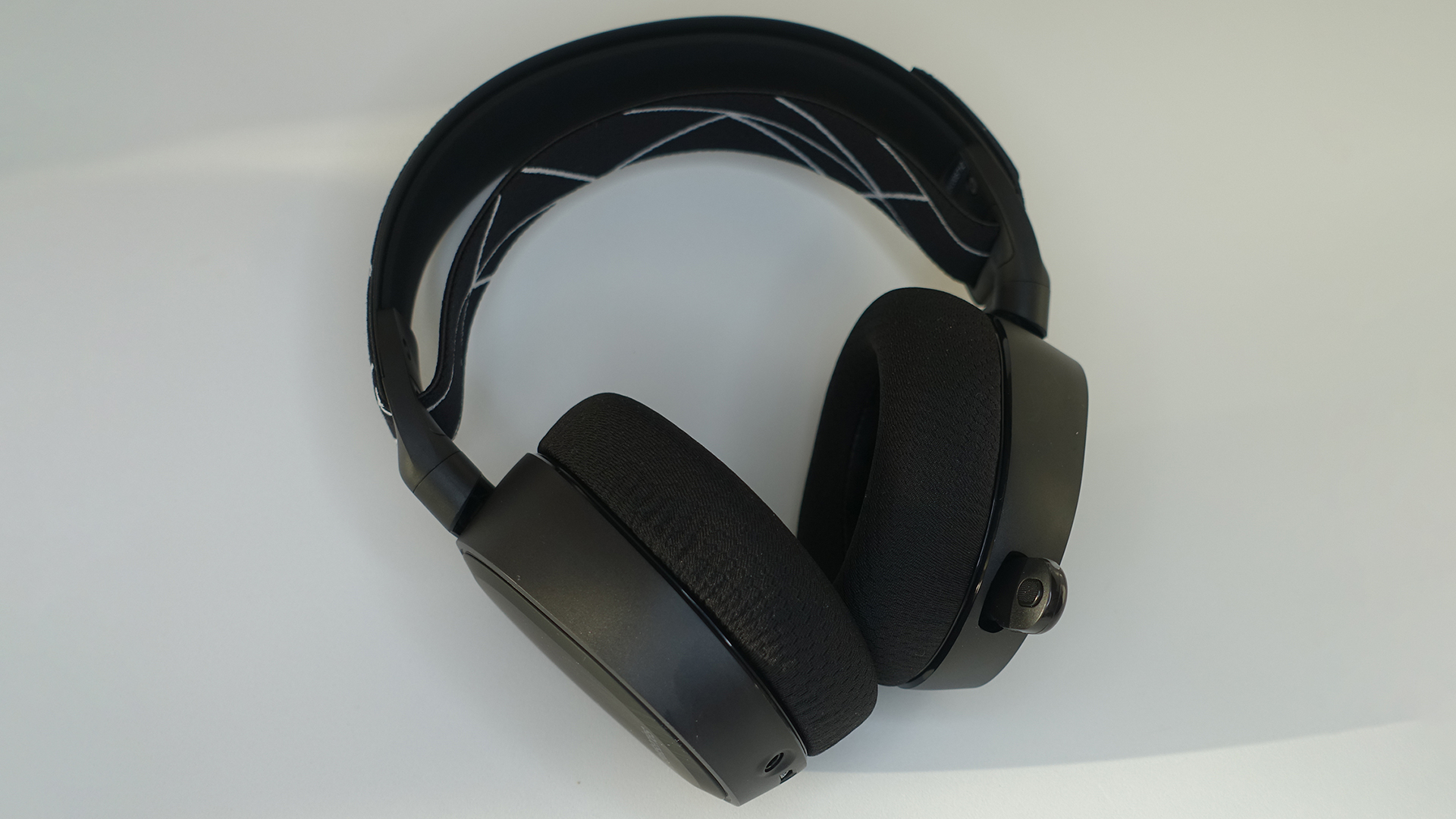
If you’re looking for a tether-free gaming headset, the SteelSeries Arctis 9 Wireless is a terrific option. The ski goggle design means it's easy to put on, the button placement is great and the retractable microphone is an option more manufacturers should look at.
That said, competitors have caught up to SteelSeries in terms of audio quality, offering larger 50mm drivers and more robust digital audio tweaks via software.
But the biggest problem with the Arctis 9 Wireless is you're essentially paying $50 more than the very similar SteelSeries Arctis 7, for the addition of Bluetooth.
Then there’s the competitors in the $200 price range. The Logitech Pro X Wireless is the same price as our review focus, and the Razer BlackShark V2 Pro is $20 cheaper. The Arctis 9 Wireless is a great headset, but it's a great headset in a space that's becoming more crowded in 2020 and beyond.
Bluetooth can be handy though. The ability to roll from being in the box to being connected to your device in minutes is also a boon. The Arctis 9 Wireless is still a winner for the Arctis line overall, but I'd caution buyers to look at the Arctis 7 if Bluetooth and dual connectivity isn't really necessary.
-
Goodfaler Reply
Hi! In the review you mentioned about tweaking SteelSeries Engine 3 settings to make this headphones sound better and bass become "good", could you please share your settings as a screenshot or so? Will be much appreciated! Thanks!Admin said:The SteelSeries Arctis 9 Wireless gaming headset sounds mostly great, but if you don't need Bluetooth, the $50 premium over the Arctis 7 may be hard to swallow.